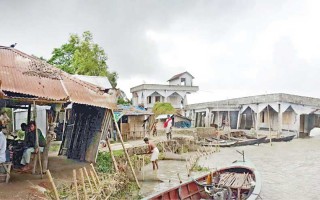Flood inundates new areas
Flood situation in the northern districts worsened as many new areas were inundated and the Brahmaputra-Jamuna and the Ganges-Padma river systems continued to swell flowing above the danger levels on Tuesday.
Several thousand of people were marooned in Lalmonirhat, Kurigram and Sirajganj and they were facing acute crisis of drinking water, food and shelters due to increasing water level.
Flood Forecasting and Warning Centre executive engineer Sazzad Hosain told New Age Tuesday that due to onrush of flood water from the upstream India, the country’s rivers were overflowing and such swelling would continue for at least three or four more days.
He said that onrush of water from Assam and Arunachal provinces of India was swelling Brahmaputra and Jamuna while onrush of water from Bihar and Uttar Pradesh was swelling Ganges and Padma.
According to the flood forecasting centre, the Brahmaputra-Jamuna and Ganges-Padma river systems were in rising trend while the River Kushiyara was in falling trend.
The Brahmaputra, the Jamuna and the Padma might continue rising in the next 48 hours from Tuesday morning, said the centre.
Bangladesh Water Development Board officials said they were aware of the facts that water level in the rivers in upper riparian India was rising due to monsoon and accordingly the flood forecast reports were made here.
The technical committee working on the Teesta water sharing issue was informed about the opening of Teesta barrage gates at Gajoldoba in India, a senior Joint Rivers Commission official said.
A foreign ministry official
confirmed that there was no communication through diplomatic channel with India over the flood situation deteriorated by the sudden onrush of waters from the upstream India.
New Age correspondent in Lalmonirhat reported that hundreds of people were marooned in floodwater in the district due to the rise of water levels of Dharla and Teesta rivers following heavy downpour and onrush of water from upstream hilly areas in India.
Over one lakh people of shoal areas of Teesta and Dharla rivers were trapped in floodwater.
At least 63 villages of Hatibandha, Kaliganj, Aditmari and Lalmonirhat sadar upazilas had been remaining under floodwater for past few days.
The water level of the Teesta River was flowing 18 centimetres above the danger level while Dharala River water was flowing 15 centimetres above the danger mark.
Embankments in Shiberkuti area of Kulaghat upazila and in Dhuni area of Hatibandha broke down as Indian government opened 54 gates of the Teesta barrage at Gajoldoba.
Following the incident, the Teesta Barrage Authority was trying to control the water opening 44 gates of the barrage, said water development board local officials.
The people were suffering from scarcity of pure water, sanitation, food and shelters, witnesses said.
Water development board executive engineer Mostafizur Rahman said that the Teesta began swelling Sunday midnight and crossed the danger level. As the pressure of water from the upstream increased, the authorities opened all the 44 gates of Teesta Barrage Monday morning.
‘All gates of Gajoldoba Barrage near Shiliguri in India are kept open due to the onrush of water from hills. Therefore, the water level on our side is increasing alarmingly,’ Mostafizur said.
Zarina Begum, 47, a housewife at Gobordhan village of Aditmari upazila, said there was floodwater everywhere inside her house and she could not cook.
‘We need dry food immediately, but we cannot afford it,’ she said.
Finding pure drinking water became a concern as, villagers said, most of the tube-wells went under water.
Mofazzal Hossain, chairman of Rajpur union parishad at Lalmonirhat sadar upazila, said that the authority could not distribute relief materials to the flood-affected people as ‘we didn’t get any allocation.’
Lalmonirhat deputy commissioner AFM Alauddin Khan said that 520 packets of dry food, 160 tonnes of rice and Tk 1 lakh in cash had been allocated, which would be distributed today.
New Age correspondent in Kurigram reported that flood situation worsened in the district.
Water level of all the rivers increased due to onrush of flood water from upstream inundating new areas marooning about one lakh people as the Brahmaputra was flowing 20cm above the danger mark at Chilmari point and the Dharla was flowing 12cm above the danger mark at Dharla bridge point on Tuesday.
About 300 villages of 35 unions at Nageswari, Ulipur, Chilmari, Roumari, Rajibpur and Kurigram sadar upazila were inundated.
Kurigram Zila Parishad member Mominul Islam Khandoker said that he visited many flood affected areas and found that the plight of flood victims knew no bound.
The affected people took shelter at flood control dykes, high lands and flood shelters.
Acute crisis of pure drinking water prevailed as most of the tube wells went under water. Fodder crisis caused farmer to sell cattle at low prices, local sources said. About 100 educational institutes remained closed due to inundation of flood water.
New Age correspondent in Sirajganj reported that flood situation in the district worsened due to increased onrush of water from upstream India. Water level in the Jamuna at Sirajganj hard point swelled to 45cm above the danger mark on Tuesday from 16cm above danger mark on Monday.
Adjacent villages and areas in Sirajganj sadar, Kazipur, Belkuchi, Chauhali and Shahjadpur upazilas were inundated afresh. District relief and rehabilitation officer Abdur Rahim said that they were yet to prepare the list of the flood-affected people and damaged properties.
Water development board executive engineer Syed Hasan Imam said that parts of Kasbar embankment at Machuakandi of Kazipur were washed away.
Swelling in Januama increase erosion of the river bank, he said.
News Courtesy: www.newagebd.net











